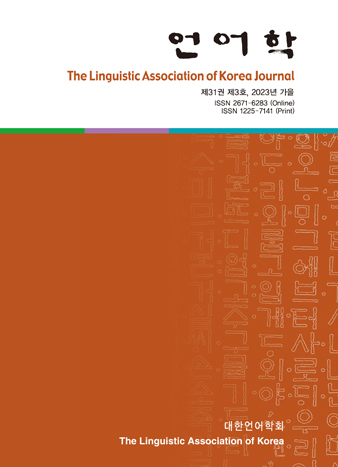대한언어학회 전자저널

-
온라인 수업에서 상호작용 교수설계가 학습몰입과 학습지속의향에 미치는 영향: N대학 교양영어 수업의 사례를 중심으로
-
The Internal Structure of Reflexives and a NP-internal Movement Analysis
-
Chinese Undergraduate Students’ Motivation to Learn L2 English and L3 Korean Simultaneously
-
What Restricts or Boosts the Use of Internally-Headed Relative Clauses in Korean?
-
English Wh-Question Formation by Korean Elementary and Middle School EFL Students
-
Korean ESL Learners’ Individual Differences in Intercultural Sensitivity and Language Development
31권 3호 (2023년 9월)
- Exploring the Use of -ese and -nikka by English-Speaking Learners on the Basis of Corpus-Based Learner Data
-
Sun Hee Hwang
Pages : 195-215
Abstract
Keywords
# causal connectives # content domain # epistemic domain # epistemic domain # corpus-based study
References
- Evers-Vermeul, J., & Sanders, T. (2011). Discovering domains – On the acquisition of causal connectives. Journal of Pragmatics 43(6), 1645-1662.
- Hong, J. (2012). Connective polysemy and clause linkage typology in Korean. Unpublished doctoral dissertation, University of California at Berkeley.
- Hwang, H. (2004). Hankuke Censan Hyengthayron. Seoul: Worin Publishing.
- Hwang, H. (2008). Yenkyelemy ‘-ese, -nikka’ uy uymy kinungkwa hwuhayngcel yuhyeng (‘The semantic function of conjunctive ending ’-eoseo, -nikka’ in Korean’). Kukehak 51, 57-89.
- Hyland, K. & Milton, J. (1997). Qualification and certainty in L1 and L2 students’ writing. Journal of Second Language Writing, 6(2), 183-205.
- Jiang, Q. (2020). Hankwuke inkwakwankye yenkyelemi ‘-ese’wa ‘-nikka’uy sayong mich olyu yangsang yenkwu: cwungkwukekwen haksupca-lul taysangulo (‘A research for the usage and error patterns in Korean conjunctive ending ‘-ese’ and ‘-nikka’: Targeting at Chinese Korean learners‘). Unpublished master’s thesis. Yonsei University.
- Lim, J. (2009). Hankwuke haksupca-uy yenkyelemi ‘-ase/ese’ey tayhan olyu yenkwu (A research for the Korean learner’s error in the connective ending ‘-ase/ese’). Unpublished Master’s thesis. Chongju University.
- Kwon, I. (2012). Forward causality in basic communicative spaces networks: the –ese and -nikka constructions in Korean. Discourse and Cognition, 19(1), 1–27.
- Lardiere, D. (2009). Some thoughts on the contrastive analysis of features in second language acquisition. Second Language Research 25(2), 173-227.
- Lee, E-R. (2013). ‘Kyelkuk’uy uymywa hwayongcek kinung (‘Semantic and pragmatic functions of ’kyeolguk’). Hanmincokemwunhakhoy 64, 5-36.
- Lemen, H., Lieven, E., & Theakston, A. (2021). A comparison of the pragmatic patterns in the spontaneous because- and if-sentences produced by children and their caregivers. Journal of Pragmatics 185, 15-34.
- Lukoff, F., & Nam, K. (1982). Constructions in -nikka and -ese as logical formulations. In The Linguistic Society of Korea (Ed.), Linguistics in the morning calm: Selected papers from SICOL-1981 (pp. 559–583). Seoul: Hanshin.
- Pander Maat, H., & Degang, L. (2001). Scaling causal relations and connectives in terms of speaker involvement. Cognitive Linguistics 12(3), 211–245.
- Pander Maat, H., & Sanders, T. (2000). Domains of use or subjectivity? The distribution of three Dutch causal connectives explained. In E. Couper- Kuhlen & B. Kortmann (Eds.), Cause, condition, concession and contrast: Cognitive and discourse perspectives (pp. 57–81). Berlin & New York: Mouton de Gruyter.
- Pander Maat, H., & Sanders, T. (2001). Subjectivity in causal connectives: An empirical study of language in use. Cognitive Linguistics 12(3), 247–273.
- Park, J. (2020). A study on causal connective ending ‘-eseo’ and ‘-nikka’. Unpublished doctoral dissertation, Seoul National University.
- Park, Y. (2015). A grammar of mood and clausal adjunction in Korean. Unpublished doctoral dissertation. University of Delaware
- Ree, J. (1977). A reanalysis of (u)ni and (e)se. In Kim, Chin-W. (Ed.), Papers in Korean linguistics: Proceedings of the symposium on Korean linguistics (pp. 177– 184). Columbia: Hornbeam Press.
- Sanders, T. J., & Spooren, W. P. (2015). Causality and subjectivity in discourse: The meaning and use of causal connectives in spontaneous conversation, chat interactions and written text. Linguistics, 53(1), 53-92.
- Sohn, S.-O. (1993). Cognition, affect, and topicality of the causal particle -nikka in Korean. In Clancey, Patricia M. (Ed.), Japanese/Korean linguistics, vol. 2 (pp. 82– 97). Stanford: CSLI Publications.
- Stukker, N., Sanders, T., & Verhagen, A. (2008). Causality in verbs and in discourse connectives. Converging evidence of cross-level parallels in Dutch linguistic categorization. Journal of Pragmatics, 40(7), 1296–1322.
- Sweetser, E. 1990. From etymology to pragmatics. Cambridge: Cambridge University Press.